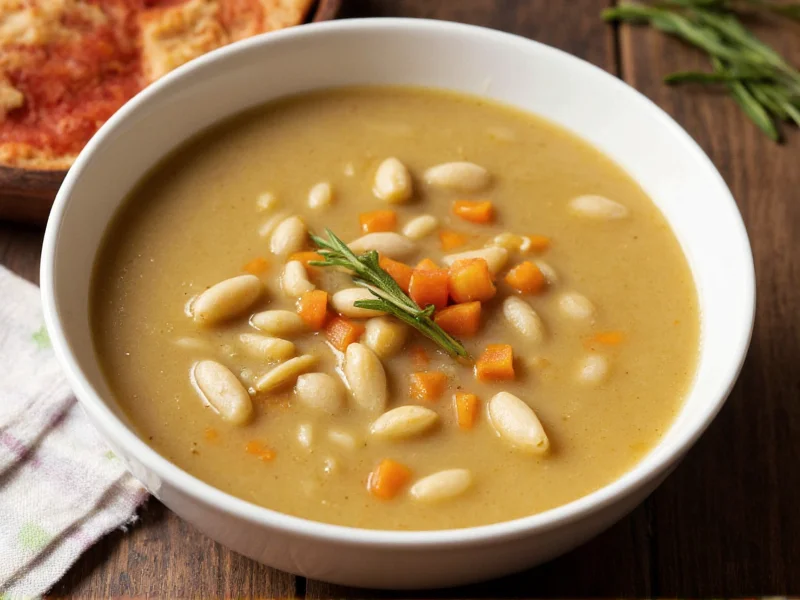Originating from Native American culinary traditions and later embraced in Southern cooking, lima bean soup has evolved into a beloved comfort food across many cultures. Whether you're preparing a simple weeknight meal or a special holiday dish, understanding the proper techniques for cooking lima beans ensures optimal texture and flavor absorption.
The Nutritional Powerhouse in Your Bowl
Lima beans deserve recognition as a nutritional powerhouse. A single cup of cooked lima beans provides approximately 15 grams of protein and 13 grams of dietary fiber, making lima bean soup an excellent choice for vegetarians and health-conscious eaters. These butter beans (as they're sometimes called) are rich in iron, potassium, magnesium, and B vitamins, particularly folate.
When prepared as a soup, lima beans retain most of their nutritional value while becoming more digestible. The addition of vegetables like carrots and celery enhances the vitamin content, while herbs and spices contribute antioxidants without adding significant calories. For those following heart-healthy diets, lima bean soup naturally contains zero cholesterol and minimal saturated fat.
| Nutrient | Per Cup (Cooked) | Daily Value % |
|---|---|---|
| Calories | 216 | 11% |
| Protein | 14.7g | 29% |
| Fiber | 13.2g | 53% |
| Folate | 256mcg | 64% |
| Iron | 4.5mg | 25% |
Mastering the Perfect Lima Bean Soup Recipe
Creating an exceptional lima bean soup requires attention to ingredient selection and cooking technique. For the best results when making lima bean soup from scratch, start with high-quality dried beans rather than canned for superior flavor and texture control. Sort through the beans to remove any stones or debris, then rinse thoroughly before soaking.
Many home cooks wonder how long to cook lima bean soup properly. After an 8-hour soak, simmer the beans in fresh water for 45-60 minutes before adding other ingredients. This two-step cooking process prevents the beans from becoming mushy while ensuring they're fully tender. When preparing creamy lima bean soup with ham, add the meat during the second cooking phase to prevent overcooking.
Essential Ingredients Breakdown
The foundation of traditional Southern lima bean soup includes:
- Dried lima beans (1 pound yields about 6 servings)
- Aromatics: 1 large onion, 2 carrots, 2 celery stalks, 3 garlic cloves
- Liquid base: 6 cups broth (vegetable or chicken) plus reserved bean soaking water
- Herbs: 2 bay leaves, 1 teaspoon thyme, fresh parsley for garnish
- Flavor enhancers: 2 tablespoons olive oil, salt and pepper to taste
For a vegetarian lima bean soup with smoked paprika, substitute vegetable broth and add 1 teaspoon smoked paprika along with a strip of kombu seaweed during cooking for umami depth. Those seeking an easy lima bean soup recipe for beginners might consider using canned beans (drained and rinsed) to reduce preparation time, though the flavor won't be as robust.
Avoiding Common Lima Bean Soup Mistakes
Several pitfalls can compromise your lima bean soup experience. Adding salt too early can toughen the bean skins, so wait until the beans are nearly tender before seasoning. Similarly, acidic ingredients like tomatoes or vinegar should be introduced in the final 15 minutes of cooking to prevent beans from remaining hard.
Many people ask how to thicken lima bean soup naturally. Instead of using flour or cornstarch, try blending 1-2 cups of the finished soup and stirring it back in. This technique creates a creamier texture while maintaining the soup's natural flavor profile. For those concerned about gas from beans, adding a piece of kombu seaweed during cooking significantly improves digestibility.
Serving and Storage Guidelines
Lima bean soup reaches its flavor potential when allowed to rest for several hours or overnight. The flavors meld beautifully, creating a more complex taste experience. When serving, consider garnishing with fresh herbs, a drizzle of good olive oil, or a sprinkle of smoked paprika for visual appeal and enhanced flavor.
Proper lima bean soup storage and reheating tips ensure quality preservation. Store cooled soup in airtight containers for up to 5 days in the refrigerator or freeze for up to 3 months. When reheating, add a splash of broth or water as the soup may thicken during storage. Never microwave soup in metal containers, and always heat thoroughly to 165°F (74°C) for food safety.
Exploring Regional Variations
Culinary traditions have shaped unique lima bean soup interpretations worldwide. In the American South, ham hocks or smoked turkey legs provide traditional flavoring. Portuguese cuisine features caldo verde with added kale, while Peruvian versions incorporate aji peppers for heat. Understanding these variations helps you customize your easy lima bean soup recipe to match your flavor preferences.
For those with dietary restrictions, numerous adaptations exist. A dairy-free creamy lima bean soup can be achieved through blending techniques rather than adding cream. Gluten-free preparation requires only ensuring your broth is certified gluten-free. When considering substitutes for lima beans in soup recipes, butter beans work identically, while cannellini beans offer a similar texture with slightly different flavor.
Final Thoughts on Perfecting Your Lima Bean Soup
Mastering lima bean soup preparation opens doors to a world of comforting, nutritious meals that satisfy both simple weeknight dinners and special occasions. By understanding the proper techniques for handling lima beans and building flavors, you can create a dish that showcases these versatile legumes at their best. Whether you prefer a traditional Southern style with ham, a creamy version for special occasions, or a vegetarian adaptation with smoked paprika, lima bean soup offers endless possibilities for customization while delivering substantial nutritional benefits in every spoonful.











 浙公网安备
33010002000092号
浙公网安备
33010002000092号 浙B2-20120091-4
浙B2-20120091-4